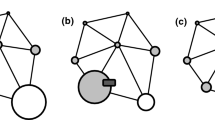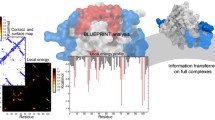Abstract
At the molecular level, most biological processes entail protein associations which in turn rely on a small fraction of interfacial residues called hot spots. Our theoretical analysis shows that hot spots share a unifying molecular attribute: they provide a third-body contribution to intermolecular cooperativity. Such motif, based on the wrapping of interfacial electrostatic interactions, is essential to maintain the integrity of the interface. Thus, our main result is to unravel the molecular nature of the protein association problem by revealing its underlying physics and thus by casting it in simple physical grounds. Such knowledge could then be exploited in rational drug design since the regions here indicated may serve as blueprints to engineer small molecules disruptive of protein-protein interfaces.
Similar content being viewed by others
References
T. Clackson, J.A. Wells, Science 267, 383 (1995).
A.A. Bogan, K.S. Thorn, J. Mol. Biol. 208, 1 (1998).
K.S. Thorn, A.A. Bogan, Bioinformatics 17, 284 (2001).
Y. Ofran, B. Rost, PLoS Comp. Biol. 3, 1169 (2007).
T. Kortemme, D. Baker, Proc. Natl. Acad. Sci. U.S.A. 99, 14116 (2002).
G.-Y. Chuang et al., Protein Sci. 19, 1662 (2010).
P. Chakrabarti, J. Janin, Proteins 47, 334 (2002).
P. Privalov et al., J. Mol. Biol. 365, 1 (2007).
J. Li, Q. Liu, Bioinformatics 25, 743 (2009).
O. Keskin, B. Ma, R. Nussinov, J. Mol. Biol. 345, 1281 (2005).
Z. Li, J. Li, Bioinformatics 78, 3304 (2010).
T. Geppert, B. Hoy, S. Wessler, G. Schneider, Chem. Biol. 18, 344 (2011).
A. Fernández, M. Lynch, Nature 474, 502 (2011).
A. Fernández, R. Scott, Phys. Rev. Lett. 91, 018102 (2003).
A. Fernández, R. Scott, Biophys. J. 85, 1914 (2003).
N. Pietrosemoli, A. Crespo, A. Fernández, J. Prot. Res. 6, 3519 (2007).
E. Schulz, M. Frechero, G.A. Appignanesi, A. Fernández, PLoS ONE 5, 12844 (2010).
A. Fernández, J. Chen, A. Crespo, J. Chem. Phys. 126, 245103 (2007).
A. Fernández, Phys. Lett. A 299, 217 (2002).
A. Fernández, R. Scott, H. Scheraga, J. Phys. Chem. B 107, 9929 (2003).
E. Schulz, L. Alarcón, G. Appignanesi, Eur. Phys. J. E 34, 114 (2011).
J.A. Wells, C.L. McClendon, Nature 450, 1001 (2007).
C.V. Sindelar, Z.S. Hendsch, B. Tidor, Protein Sci. 7, 1898 (1998).
M.J.M. Castro, S. Anderson, Biochemistry 35, 11435 (1996).
A. Böttger et al., J. Mol. Biol. 269, 744 (1997).
A. Ashkenazi et al., Proc. Natl. Acad. Sci. U.S.A. 87, 7150 (1990).
C.-Z. Chen, R. Shapiro, Proc. Natl. Acad. Sci. U.S.A. 94, 1761 (1997).
U.C. Kühlmann et al., J. Mol. Biol. 301, 1163 (2000).
G. Schreiber, A.R. Fersht, J. Mol. Biol. 248, 478 (1995).
Author information
Authors and Affiliations
Corresponding author
Rights and permissions
About this article
Cite this article
Accordino, S.R., Rodriguez Fris, J.A., Appignanesi, G.A. et al. A unifying motif of intermolecular cooperativity in protein associations. Eur. Phys. J. E 35, 59 (2012). https://doi.org/10.1140/epje/i2012-12059-0
Received:
Revised:
Accepted:
Published:
DOI: https://doi.org/10.1140/epje/i2012-12059-0




